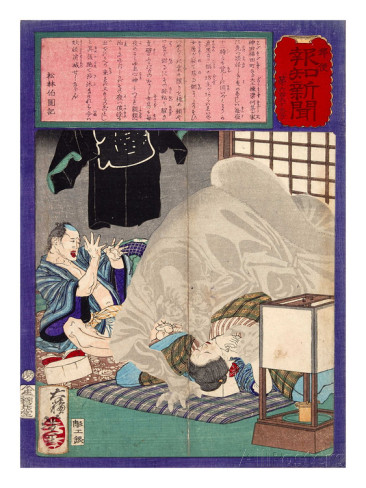Translated and Sourced from Mizuki Shigeru’s Mujara, Japanese Wikipedia, and Other Sources
If you wake up after a restless night, with reeking breath and gasping for air—beware! You might have had a visit from the breath-stealing Kurobozu; the Black Monk.
What Does Kurobozu Mean?
It doesn’t get less complicated than this! 黒 (Kuro; Black) + 坊主 (Bozu; Monk). As with many yokai, the “monk” part does not have any particular religious meaning. Many yokai have this as part of their name, which could just as easily mean “stranger.” Kurobozu is also used as an alternate name for other yokai like the umibōzu and takabozu.
During the Edo period, classes and traveling were high restricted. Most were not permitted to leave their home town, and posted waypoints on the road rigorously checked passports to make sure everyone stayed put. Itinerant monks were one of the few classes allowed free travel, so they were often the only unfamiliar faces who ever wandered into town.
That and the bald heads. Almost every yokai with “bozu” in its name is inevitably bald.
What Does a Kurobozu Look Like?
Aside from the bald head, the Kurobozu is depicted as vaguely human-like, although shrouded in a pitch black monk’s robe. It is like a living shadow. Its head is featureless, except for the vague appearance of two eyes that sometimes reflect the light. The lack of face leads some to consider the Kurobozu to be a type of Nopperabo.
Based on the two types of Kurobuzo stories, the images are often merged into a bear-like monster wrapped in a monk’s robes.
The Kurobozu of Tokyo
During the Meiji period (1868 – 1912), sensationalist newspapers ran illustrated stories of crime, yokai, and other supernatural happenings. These stories were often very short; a bit of text accompanied by an eye-catching illustration. This is how the Kurobozu entered the yokai pantheon, in the 663rd issue of the Yubinhouchi Shinbun (郵便報知新聞; Postal Intelligence Newspaper).
A family living in the Kimata area of Tokyo reported a strange disturbance. Each night while they were sleeping a strange presence would appear in their bedrooms. The presence hovered over the wife, leaning close to her. It slobbered over her face, and sucked her sleeping breath from her mouth. In the morning, the wife’s breath and face would stink of rotting flesh. She fell ill. Unable to tolerate it any longer, the wife went to stay at a relative’s house. The mysterious Kurobozu did not follow her there, and she was able to recover her health. After some time, she returned home and has reported no further disturbance. The Kurobozu has disappeared.
The Kurobozu of Kumano
There is another legend of a creature called a Kurobozu that comes from the Edo period, and is recorded as a local legend of Kumano in the kidan-shu Sankawa Kidan (三州奇談; Romantic Tales of Three Rivers).
The story tells of a hunter who encounters a large, black monster out in the woods, looking something like a black bear. When the hunter shot it with his rifle, the monster grew in size until it was several meters tall. Terrified the hunter fired again, and the monster fled, moving over the difficult terrain at an incredible pace, almost as if it was flying.
Translator’s Note:
I am writing up some yokai to be used in the Pathfinder roleplaying game bestiary. The Kurobozu is one of these! (Expect more to come!)
The Kurobozu is one of many yokai about which little is known other than these two stories. It is very similar in appearance and actions to the yokai called yamachichi (山地乳), a monkey-like monster that also sneaks in at night to suck up a sleeper’s breath.
There are obvious explanations for both these yokai—either a cat snuggling up on a sleeper’s chest appearing monstrous when seen through the eyes of someone still half in dream, or the well-known phenomenon of sleep paralysis.
But no matter the real-world explanation, the Kurobozu still makes a pretty cool monster. So if you are a fan of pen-and-paper roleplaying games, go dive into the world of Pathfinder and do battle with some yokai.



Jul 09, 2015 @ 10:12:20
I’ve experienced sleep paralysis 2 times and it is frightening and feels very much like being held down by someone.
Jul 09, 2015 @ 16:56:08
I love how you always find little stories that are pretty much unknown to everyone but very dedicated fans of yokai. This one was sort of scary, but I’ve found that apparitions while one sleeps/is about to fall asleep/just waking up are very common, like the “visitors” that seem to be common amongst sleep paralysis sufferers…
As Jason up there, I’ve suffered sleep paralysis (rather often for a while, then now and then) and while I’ve never seen anything strange, I understand how fearsome it is and how this legends can get popular!
Jul 09, 2015 @ 21:57:20
What is a Nopperabo?
Jul 13, 2015 @ 01:40:04
A faceless ghost.
Aug 18, 2015 @ 17:47:54
https://hyakumonogatari.com/2012/08/19/shirime-eyeball-butt/ <- See here
Nov 05, 2015 @ 10:39:51
http://yokai.com/nopperabou/